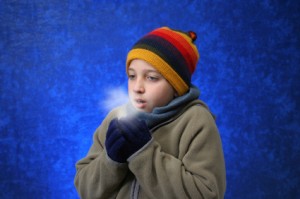
Few discomforts are more annoying and potentially dangerous than being cold. The body loses heat through four different means: evaporation of moisture at or near the skin, conduction, convection and radiation.
Evaporation: Moisture is lost through the sweat glands. When the moisture is turned to vapor, heat is extracted from the body. When clothing becomes wet from perspiration or other sources, it becomes less insulative, allowing the body to cool. Wool and some synthetics insulate better than other fabrics when wet, but no clothing is really warm when it is wet.
Conduction occurs when heat is transferred directly through a medium. This type of heat loss is minimal with a reasonable amount of clothing. The blood vessels in the outer areas of the body constrict in the cold to keep heat in the more vital areas and slow conductive heat loss. An exception to this is in the head. You should always keep your head and neck well covered.
Convective heat loss occurs when heated air rises and is replaced by cold air. This can occur around layers of poorly fitted or constructed clothing.
Electromagnetic radiation of body heat is a major avenue of heat loss. Most thick outer garments, such as heavy coats, are substantial enough to minimize radiant heat loss. Radiant barriers constructed of shiny material with non-conductive layers also reflect heat from the body very effectively. "Space" or "emergency" blankets made of this material are, for space and weight, the best emergency protection around.
Natural and synthetic insulations of good quality are available for clothing and sleeping gear. Down is a premier natural insulation. It is lightweight and durable; clothing made with down drapes well. Down sleeping bags are wonderful, but in extreme cold, body moisture collects and freezes the down into clumps, thereby reducing its insulative value.
Synthetic insulations now compete favorably with the best of the natural. They are resilient, compactable and retain much of their insulative quality when wet. They also dry much faster than down and are less expensive.
Cold weather clothing is most serviceable when worn in layers, allowing them to be added or removed to adjust to immediate needs. An outer layer should be water and wind resistant. Next to the skin, wear a good undergarment followed by appropriate clothing. Thick insulative layers should fill the space between the outer shell and the undergarments. Temperature adjustments can be made by opening or closing at the top and bottom to allow for, or stop, air circulation.
By J. Allan South, Author of Sense of Survival
Used by Permission

